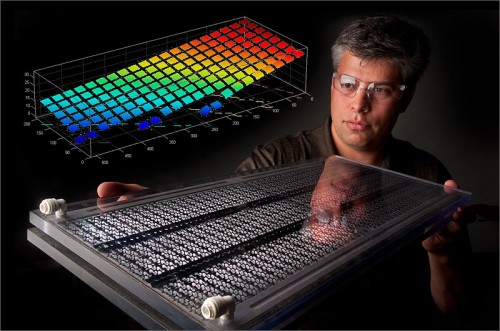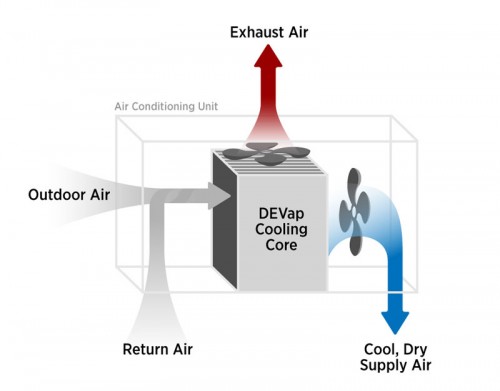DEVap: An Energy-Saving Air Conditioning Design
Unless it suddenly becomes socially acceptable for the thermally blessed to wear tank tops and shorts to the office, I think it’s safe to assume that air conditioning will continue to enjoy widespread use – despite the fact that it accounts for 5 percent of the 40 quadrillion British Thermal Units expended annually in American buildings (according to the U.S. Energy Information Administration). Those of us who enjoy high surface area to volume ratios and poor circulation often point out the high cost in resources and dollars of setting the temperature low in hot weather, and so it’s with a bit of a pained smile that I will relate the following very good news, which completely undermines my argument:
Researchers working at the U.S. National Renewable Energy Laboratory (NREL) in Golden, CO, have developed “a new air-conditioner design that they say will dramatically increase efficiency and eliminate gases that contribute to global warming” (Savage). The air conditioner utilizes the principles of indirect evaporative cooling paired with a desiccant to further absorb moisture.
Image credit: Pat Corkery
Here’s how the desiccant-enhanced evaporative, or DEVap, air conditioner works. A polymer membrane coated with both a teflon-like substance that repels liquid water and a desiccant divides the air flowing through the system into two streams. The membrane has pores about 1 micrometer to 3 micrometers in diameter; these are large enough for water vapor to pass through but too small for the desiccant to sneak across. The desiccant draws moisture from the airstream, leaving dry but warm air. Indirect evaporative cooling takes place in a secondary chamber, chilling the other half of the divided airstream. As the air in the second chamber grows cooler and wetter it cools the dividing membrane, which in turn cools the first airstream, and out of the machine comes cool, dry air. The process uses up to 90 percent less energy, depending upon the humidity of the air that goes into the system at the start (Source: NREL).
Image Credit: NREL
NREL’s liquid desiccant takes the form of a 44% salt by volume solution of lithium chloride or calcium chloride (aka road salt). The corrosiveness of the salt “requires that metal be eliminated from the hardware. What’s particularly attractive is that it replaces the chlorofluorocarbons that are used as the refrigerant in traditional air conditioners. Those CFCs can easily leak, and every kilogram of them provides the same greenhouse gas effect as about 2,000 kilograms of carbon dioxide” (Savage). When the desiccant has absorbed too much water it can be heated to boil off the excess moisture. The system could take advantage of waste heat from industrial processes, or gather heat from solar energy that might otherwise go to waste.
NREL plans to hand off the design to industry for commercialization in about five years, which sounds like a long time – but you might just think of it as until the next World Cup plus one year. Another bonus is that the system has been designed to replace existing systems without many changes, meaning that it would be an air conditioner upgrade rather than an infrastructural overhaul. Either way, it looks like I’ll be wearing sweaters in June for a long time…
WU XING:
This post is all about water.
Cited:
“Energy Saving A/C Conquers All Climates.” NREL. 06/11/10. Accessed 06/17/10. URL.
Savage, Neil. “An Energy-Saving Air Conditioner.” Technology Review. 06/17/10. Accessed 06/17/10. URL.

















[…] Read more here: DEVap: An Energy-Saving Air Conditioning Design | ARCHITERIALS […]
“I used to have a personal heater at my desk to counteract the effects of the arctic blast aimed roughly at the top of my head, but the heater voided the warranty on our cubicles so I had to take it home.”
Did you heater not also kill the power supply of your computer, once upon a time?
You are correct sir.
—“NREL’s liquid desiccant takes the form of a 44% salt by volume solution of lithium chloride or calcium chloride (aka road salt). The corrosiveness of the salt requires that metal be eliminated from the hardware”—
perhaps Liquidmetal Technologies can provide a perfect solution for the corrosiveness issue.
normal evaporative cooling is generally not effective in a high humidity climate like miami…will this technology be effective there?
currently chinese introduced adsorption chillers that save upto 90% of your cooling bill. not only that it is extremely low maintenance as it does not have a compressor and uses some sort of gell the apparently cools hot water! and it also cna be used as a heater in winter! i think time is comming that europeans will have to start copying the chinese.
What’s not clear is, now does the dessicant dry out and continue to absorb water? What takes away the water?
In traditional evaporative coolers (“swamp coolers”) the water absorbs heat and evaporates, and is replaced by more water. But there’s no incoming stream of dessicant.
Leave a Wordpress Comment:
Ads
Watch ARCHITERIALS Videos on vimeo
Like on Facebook
Twitter
Flickr
Hit Counter
Ads
Blogs
Green
Journals/Publications
Materials
Network/News
Offices/People
Resources
Science
Pages
Archive
RSS and Email Subscriptions
Tag Cloud
3D 3D printer AB FAB academic acid acrylic actuated matter adaptive adhesive adsorption aerogel air air conditioning alloy aluminum amnh antibacterial antifungal ants april fool's architecture architecture robot artificial skin autonomous aviation awesome bacteria bamboo bananas beer bench bend bending biennale biocomputing biodegradable biodegradeable biomaterials biomimetics biomimicry biominerals biopolymer birds blast blast-resistant block blocks blogs Bloom Box brazil brick bubbles bucky bulk metallic glass butterfly calera canvas carbon carbon fiber carbon nanotubes carpet cars ceiling cellulose cement ceramic chain link chair charcoal charlie sheen chemicals chiller clay cloth cloud cmu coils color color-changing communication compound computer concrete condensation conducting conductive context cool coral cracks crystal cyborg demakersvan design digifab dirt disaster dna dror drywall dutch dynamic EAP earth ecocradle ecolect e coli ecology ecoresin ecovative elastic electric electricity electrochromic electroluminescent electronic energy energy recovery environment evaporative cooling experiment fabric fabrication facade fiber fiberglass fiber optic fiber optics fibers film FIRE flexible flickr fly ash foam fungus furniture garbage gel geodesic dome geometry gfrp gilgamesh glass glass fiber glow glue gold graphene green greensulate gsapp gypsum hard heat heavy heidi klum helix hemp hexagon hidden high performance hive honeybee humidity ice India ink insulation interference Internet inventables invisible invisible ink jello jellyfish just add water kevlar kinetic korea lace lamboo laser lattice leaves LED leed LEGO light light emitting light transmitting liquid lo mein london Loop.pH machines magic magnetic marine material materials meatball melting memory metabolic engineering METAL metal panel metamaterial micro microsensor microtools military milk MIT moisture multi-layer mushrooms mycelium nano nanogel nanotech nanotubes NASA new noise non-metallic oil OLED OMA ostrich oysters packaging paint panel panels paper paperfoam paraffin wax particles particulates petroleum phase change phosphorescent pink PLA plastic platinum pm-10 poetry pollution polymer polymers porcelain power precast printed printing protein public quadror radiant rain rammed earth reclaimed recycled reflective refracting Rem Koolhaas resin robot robotics roof rubber rugged sand sealant sealer search segmented self-healing sensor shape memory silica silicon silk skin skittles slats smog soft solar solar cell solar cells solar paint solid solid state lighting sound spider spider glue spray stabilized sand stone stretch stretchable strong structural structure studio dror sun sunglasses super supercritical sustainable switzerland tags tape technology TED tensile TEXAS textile textiles texture thermal thermochromatic thin thin film thread tiger stone tile tiles timber tio2 tires toaster tokujin yoshioka touch touch-sensitive toxic transparent t shirts tulip ultra-thin university of akron university of connecticut upcycling virus voc wall wallpaper WATER web wet whale wires WOOD woodwool wool workshop
WP Cumulus Flash tag cloud by Roy Tanck and Luke Morton requires Flash Player 9 or better.
Recent Comments
Ads
Recent Posts
Most Commented
Most Viewed